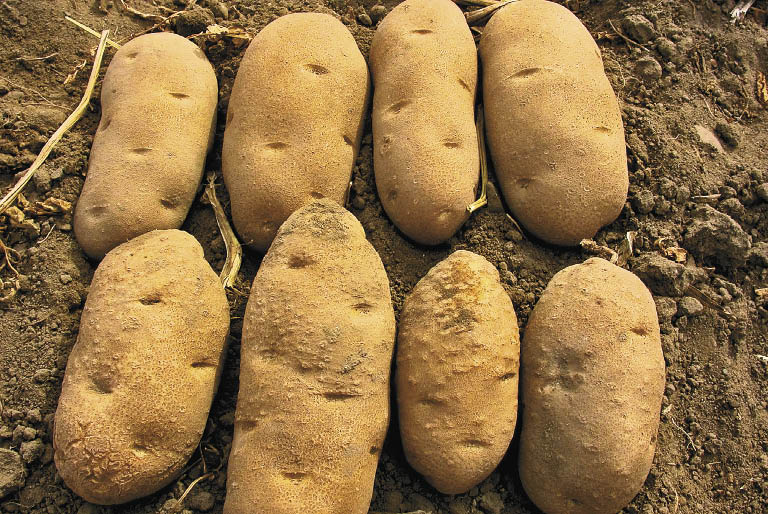 Most of the northern tier of the United States has enjoyed mild weather over the past winter and early spring. Potato pests were enjoying the same warmer-than-average temperatures, so it is likely growers will see heavier pest pressures this season.
Most of the northern tier of the United States has enjoyed mild weather over the past winter and early spring. Potato pests were enjoying the same warmer-than-average temperatures, so it is likely growers will see heavier pest pressures this season.
"We usually count on prolonged cold winter temperatures to reduce nematode populations each year, but many potato-growing regions did not experience a normal winter," says Russ Ingham, nematologist at Oregon State University. "In the Pacific Northwest, the last few winters have been fairly mild, and nematode populations haven't changed much from fall to spring each year. That will probably be the case this season across much of the northern potato-growing areas-spring nematode populations will be higher than usual."
Faster spring soil warm-up also is likely to increase nematode pressure after planting, says Hector Portillo, product development manager, DuPont Crop Protection. "With warm temperatures, more potato nematodes survive high in the soil profile compared to a normal winter. They are likely to infest roots more quickly and will be more prevalent earlier in the season this year."
Soil sampling to identify nematode species and counts helps growers decide whether fumigation is necessary prior to planting. Even with use of an at-plant insecticide/nematicide, a second soil test may be needed after planting to confirm the first sampling and ensure that any previous control efforts were effective, says Portillo. "The potential for crop damage is too great to leave in-season pest control to chance, so timely foliar applications may be necessary throughout the growing season."
Value of Good Nematicide
Research from Oregon State University and Washington State University shows the positive effect of a well-timed nematicide application on potato quality. Trials conducted in 2010 and 2011 tallied the percentage of culled potatoes at just 1 to 6 percent in crops protected against root-knot nematode with a program including DuPont Vydate C-LV insecticide/nematicide, compared to cull rates of 35 to 95 percent in untreated crops.
"Vydate C-LV protects potato plant roots from being damaged by nematodes," says Norman McKinley, senior field development representative for DuPont Crop Protection. "It's fast-acting and interrupts nematode feeding, movement, reproduction and hatching within minutes." Nematodes are a major pest threat, and growers have very few options for controlling them, he says. "Vydate C-LV is highly systemic and moves up and down within the plant to protect the entire plant, both above and below ground.
"By protecting the whole plant-roots and foliage-you have a healthier plant that produces at maximum yield potential," he adds. "Vydate C-LV is a proven, effective in-season insecticide/nematicide that also offers control of key foliar insects, including aphids, leafhoppers and Colorado potato beetle."
Major Insect Threat
The Colorado potato beetle continues to be one of the most formidable potato pests. In all stages, from larva to adult, the insect can feed on any part of the potato plant, hurting yield. The best control strategy is a multi-pronged approach, including field rotation, weed control and well-timed insecticide applications, says McKinley.
Being diligent about field scouting and following economic thresholds are important tools for effective insect control, he notes.
To avoid development of insecticide resistance, it is important to rotate between insecticides with different modes of action, says McKinley. "Group 1A (carbamate) insecticides, including Vydate C-LV, are effective, but need to be used alternately with insecticides having other modes of action." (Colorado potato beetles resistant to carbamates will not be controlled.)
Appropriate rotation options are available. "DuPont Coragen insect control complements Vydate C-LV nicely," explains Lars Swanson, Rynaxypyr portfolio manager, DuPont Crop Protection. "Coragen is a Group 28 (diamide) insecticide that is also effective on Colorado potato beetle and, due to its different mode of action, does not demonstrate cross-resistance to other products. Rynaxypyr, the active ingredient in Coragen, moves quickly into the leaf tissue, where it is protected from wash-off and can be ingested by pests feeding on both the outer and under sides of leaves."
With a wide window of application and residual control lasting as long as 28 days, Coragen helps protect potato plants longer than a contact-only insecticide, Swanson notes. "It also controls European corn borer, potato tuberworm and cabbage looper, and offers the flexibility of being applied as a foliar application by ground or air, or through overhead chemigation."
Developing a strategic insect control program for this warm, early season will be essential to preserving crop yield and quality throughout the year, adds McKinley. "Unchecked insect damage can have a huge impact on a producer's bottom line. That's why it is critical to stay ahead of pest infestations, before they eat up all the profits."